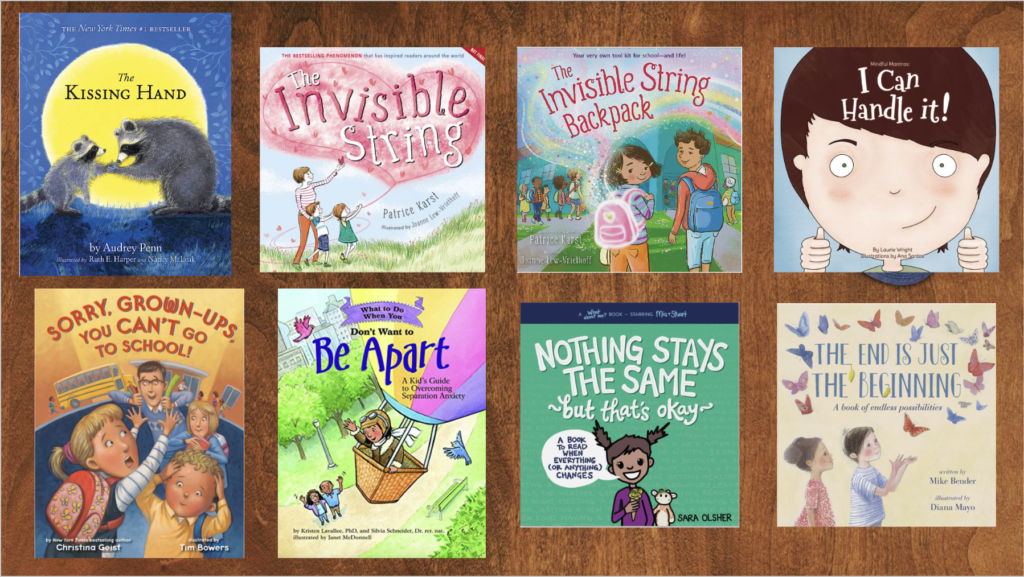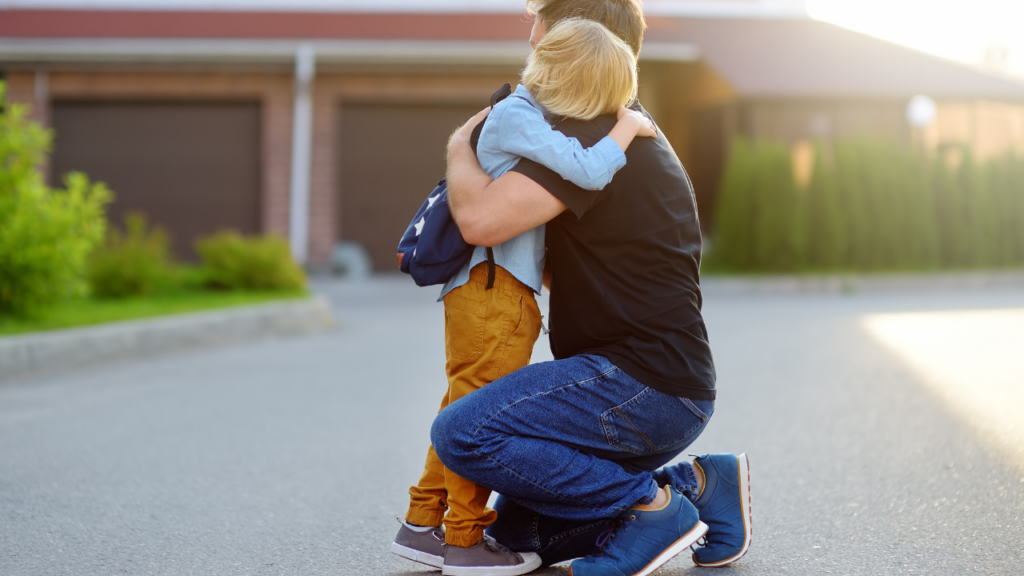Have you ever thought about the start of a new school year as similar to the process of adjusting to a change in the family? Just as families experience shifts in dynamics when changes occur, students and their families often undergo a period of adjustment once the novelty of the school year wears off. This transition can bring about a range of emotions, much like what one might feel during a family breakup. Let’s explore the parallels between family changes and the back-to-school journey, and offer insights on how to navigate the tough part of the transition, which happens once the novelty of the new year wears off.
The Classroom as a Family Unit
Throughout the school year, classrooms become microcosms of family units. The teacher assumes the role of a parent figure, guiding and nurturing the students, while the students themselves form a kind of sibling relationship. They spend 7 to 8 hours a day together, learning, playing, and growing. This daily interaction creates a bond akin to that of a familial relationship, making the classroom a second home for many students.
The Early Excitement
At the beginning of the school year, everything feels new and exciting. From brand-new school supplies to special treats packed in lunch boxes, the first day of games and even an “extra” recess, there’s a sense of promise and adventure. This initial stage often mirrors the positive spin parents put on family changes, like “two birthdays” and “two Christmases.” It’s a way of highlighting the positives to help ease the transition.
The Reality Sets In
Just like in a family breakup, the initial excitement eventually fades as the hours turn into days and the days into weeks. As the newness wears off, reality starts to set in, and this is when students might begin to miss the familiarity of their previous grade or teacher, along with the comfort of established routines. For some students, this phase indeed presents the true challenge of the transition.
It’s during this period that the classroom, while initially a group of students and a teacher, needs time to evolve into a cohesive “family.” Building that sense of connection and trust takes time. While students and teachers become familiar with each other, they’re also navigating the complex process of bonding and creating a supportive learning environment.
“I Don’t Know What’s Wrong!”
Interestingly, this time of the school year often coincides with parents reaching out because their child has expressed reluctance to go to school. It’s not uncommon for parents to be concerned when their child, who enjoyed school in the previous year, suddenly becomes hesitant. Parents might ask, “What’s wrong?” only to be met with the vague response of “I don’t know.” This uncertainty can fuel parental worries about potential bullies or difficult teachers.
Sometimes, children might even respond with “yes” when asked if someone is bothering them, even though that might not be the case at all. Elementary students, due to their limited life experience and developing communication skills, might find it challenging to express the nuanced emotions they’re experiencing during this transitional phase.
The Adjustment Process
As educators, parents, and counselors, it’s crucial for us to understand that these reactions are not always indicative of serious problems. Rather, they often reflect the natural process of adjusting to change. Children at this age are still learning to articulate their feelings and emotions, and their responses might not always align with their true experiences.
Taking the time to engage in open and patient conversations with students can provide valuable insights. Encouraging them to share their feelings and experiences, even if they can’t quite put them into words, helps create a bridge of understanding between students and the adults who care for them. By acknowledging their emotions and offering support, we can help children navigate this transition more smoothly and build the emotional skills they’ll carry forward in life.
Navigating the Transition
- Acknowledging Emotions: It’s essential for educators, parents, and counselors to acknowledge that students might experience a range of emotions during this transition. Just as one might feel sadness, anxiety, or uncertainty during a family change, students might also grapple with these feelings.
- Creating a Supportive Environment: Teachers and school staff can play a significant role in providing a supportive environment. Open discussions about emotions, changes, and the challenges of transitions can help students feel understood and valued.
- Building New Connections: Encourage students to form new connections within their new classroom “family.” Icebreaker activities, group projects, and cooperative learning can help foster a sense of belonging and camaraderie.
- Emphasizing Routine and Stability: Just as routines provide stability in times of family change, they also offer a sense of security in the classroom. Teachers can maintain consistent schedules and routines to help students feel more at ease.
- Empowering Resilience: The experience of navigating transitions can actually foster resilience in students. By addressing challenges head-on and developing strategies to cope, students can learn valuable life skills.
Little Life Lessons • Big Life Skills
As the school year progresses, the initial excitement of newness gives way to the reality of transition. Much like a family going through changes, students and families navigate a journey that involves adjusting to a different dynamic. But we can help students effectively navigate the back-to-school transition and embrace the opportunities that come with change. Just as in families, these experiences offer little life lessons that foster big life skills. Transitions aren’t just about adapting to change; they’re about learning, growing, and building a stronger sense of self.
Books on this Topic

The Kissing Hand by Audrey Penn
This beloved classic that continues to resonate with children and parents alike. The heartwarming story explores the emotions that can accompany new experiences, such as leaving parents for the first time, and provides a practical strategy to ease those separations. As an elementary school counselor, I continue to recommend this book to parents.
In the forest, it’s time for school to begin, but Chester Raccoon is filled with reluctance. He doesn’t want to go. To help him overcome his fears, Mrs. Raccoon shares a cherished family secret called the “Kissing Hand.” This heartwarming ritual reassures Chester of his mother’s love and support whenever he feels scared or uncertain.
Since its initial publication in 1993, “The Kissing Hand” has become a timeless classic, touching the hearts of countless children and their parents, particularly during moments of separation, such as starting school, attending daycare, or going to camp. It is a treasured resource for kindergarten teachers, often read on the first day of school, to help young students transition into their new environment with confidence.
The Invisible String by Patricia Karst
This is a heartwarming book that I use every year with my new incoming kindergarteners who may be feeling nervous about leaving their parents and starting school, especially if it’s their first experience being away from home for extended periods. After reading this touching story, I give each student what I call an “almost invisible” bracelet, symbolizing the special connection between them and their grown-ups at home.
In the book, a mother tells her two children about the concept of an invisible string that connects everyone. The children are initially skeptical but curious to learn more. They inquire about the nature of this string, and the answer is beautifully simple: it’s a string made of love. While it can’t be seen with the eyes, it’s deeply felt in the heart, serving as a reminder that they are always connected to the people they love. This story explores questions like whether everyone has an Invisible String, how far it reaches, and whether it ever goes away. It offers a straightforward yet imaginative way to address separation anxiety, loneliness, or loss. The book’s powerful message about the enduring connections between loved ones is particularly relevant in today’s uncertain times. This special edition features vibrant new illustrations and an introduction from the author.
The Invisible String Backpack by Patricia Karst
By the author of “The Invisible String”, this is another valuable resource for parents, teachers, and counselors, especially when helping children adjust to the new school year, where everything can seem different and challenging. This backpack is not just an ordinary bag; it’s filled with powerful tools designed to empower young learners.
In the story, we meet Mila, who is filled with a mix of excitement and worry on her first day of school. She’s concerned about finding her classroom, making friends, and speaking up when needed. Fortunately, her brother offers sage advice: she already possesses everything she needs within her “Invisible Backpack”: an Invisible Microphone to help her find her voice, an Invisible Flashlight for those times when she feels lost, and an Invisible Net to catch her if she stumbles. The incredible thing is that her backpack is bottomless, and it grows each time she uses it.
At the heart of her Invisible Backpack is the Invisible String, the very first item she places inside. As she utilizes these tools, her inner strength and resilience grow, allowing her to face any obstacle that comes her way.
This story is not only engaging but also serves as a wonderful visual aid for social-emotional learning (SEL) lessons in the classroom, helping children build confidence, resilience, and the ability to navigate the ups and downs of the school year with courage and determination.
I Can Handle It by Laurie Wright
“I Can Handle It” is a fantastic resource for helping elementary students develop a positive and resilient mindset, particularly during challenging times like the back-to-school transition. The book employs simple, kid-friendly language and the power of repetition to instill the empowering message of “I Can Handle It” in children’s minds.
As we read this book together, children quickly internalize the idea that they can handle tough situations. This affirmation becomes a part of their self-talk, helping them face various challenges, including the uncertainties of the current times.
Whether they’re tired of staying home, missing their friends, or feeling anxious about the future, the mantra “I can handle it” becomes a reassuring presence in their thoughts. Positive self-talk is a crucial tool for promoting and maintaining strong mental health, which is especially relevant in today’s world.
Sorry, Grown-Ups, You Can’t Go to School! By Christina Geist
This is an absolutely delightful book that turns the tables on the typical school experience. This heartwarming story revolves around children who relish the fact that they are heading to a place where parents and grandparents simply can’t follow.
In this fun and interactive book, the story takes a humorous twist as Mom, Dad, Grandma, and even the family dog, Bow-wow, all plead with the kids to let them come to school. They present their cases with entertaining reasons, but the response is always the same: “Sorry, grown-ups! You can’t go to school! Only kids and teachers!”
Christina Geist’s storytelling is playful and engaging, making this book a valuable tool for parents and educators dealing with reluctant or anxious children as they face going back to school. The repetitive refrain adds to the enjoyment, painting school as something exclusive and desirable, something that only kids and teachers can access. Tim Bowers’s lively illustrations add to the fun and humor of the story.
This book has quickly become one of my back-to-school favorites. It celebrates the unique excitement and pride children feel about going to school, where they have their own world of learning and adventures away from the grown-ups.
What to Do When You Don’t Want to Be Apart: A Kid’s Guide to Overcoming Separation Anxiety by Kristen Lavallee and Silvia Schneider
This is an invaluable resource for children and adults to explore together. It’s part of the “What to Do” Series, which I use frequently in my work with individual students and small group counseling sessions. This particular book addresses the common childhood fear of being apart from loved ones and offers practical strategies to overcome separation anxiety.
The story revolves around hot air balloon pilots who embark on thrilling adventures, discovering new things and exploring the world beyond. While flying in a hot air balloon might sound exciting to some kids, for others, the idea of being away from their parents or familiar surroundings can be overwhelming. This book is specifically designed for children who feel scared or anxious when they need to do something alone or be apart from their parents.
“What to Do When You Don’t Want to Be Apart” serves as a compassionate guide, helping children and their parents navigate the complex emotions associated with separation anxiety. The book uses cognitive-behavioral principles to provide effective strategies for managing and overcoming this anxiety, empowering children to become confident “pilots” of their own metaphorical hot air balloons.
Nothing Stays the Same, but That’s Okay by Sara Olsher
Another great resource for children, parents, and educators alike, this book provides support and guidance for navigating various life transitions. This book is particularly effective in helping children understand and cope with changes, whether big or small.
Change can be unsettling for anyone, especially children who thrive on routine and predictability. When something in a child’s life changes, the familiar and safe can quickly turn into the confusing and scary. This book, through the journey of Mia and her stuffed giraffe Stuart, explores changes of all kinds and how they impact a child’s daily life.
The author introduces the concept of an overwhelmed, too-busy brain, allowing children to recognize when they may be feeling overwhelmed and providing them with various coping strategies. As a school counselor and SEL specialist, I reach for Nothing Stays the Same, but That’s Okay when working with students who are trying to navigate the complexities of transitions, whether they’re facing a new school year, changes in their family, or other life transitions. It empowers children with knowledge and practical coping skills, allowing them to embrace change with confidence. By using this book, I can effectively support students and their families as they grow and develop resilience during challenging times
The End is Just the Beginning by Mike Bender
This is a truly heartwarming book that offers a fresh perspective on endings, making it a perfect addition to my collection as a school counselor. This book beautifully conveys the idea that every ending marks the start of something new and full of potential. Its timely message of hope and resilience is something I love to share with my students, helping them navigate uncertain times and life transitions with optimism and a sense of new beginnings.
Just like in “The End is Just the Beginning,” every conclusion opens the door to fresh opportunities and adventures. So, as we wrap up here, remember that this is the end of this post, but the beginning of your journey to explore these wonderful books and empower the young minds in your life with little life lessons and big life skills. Happy reading!

